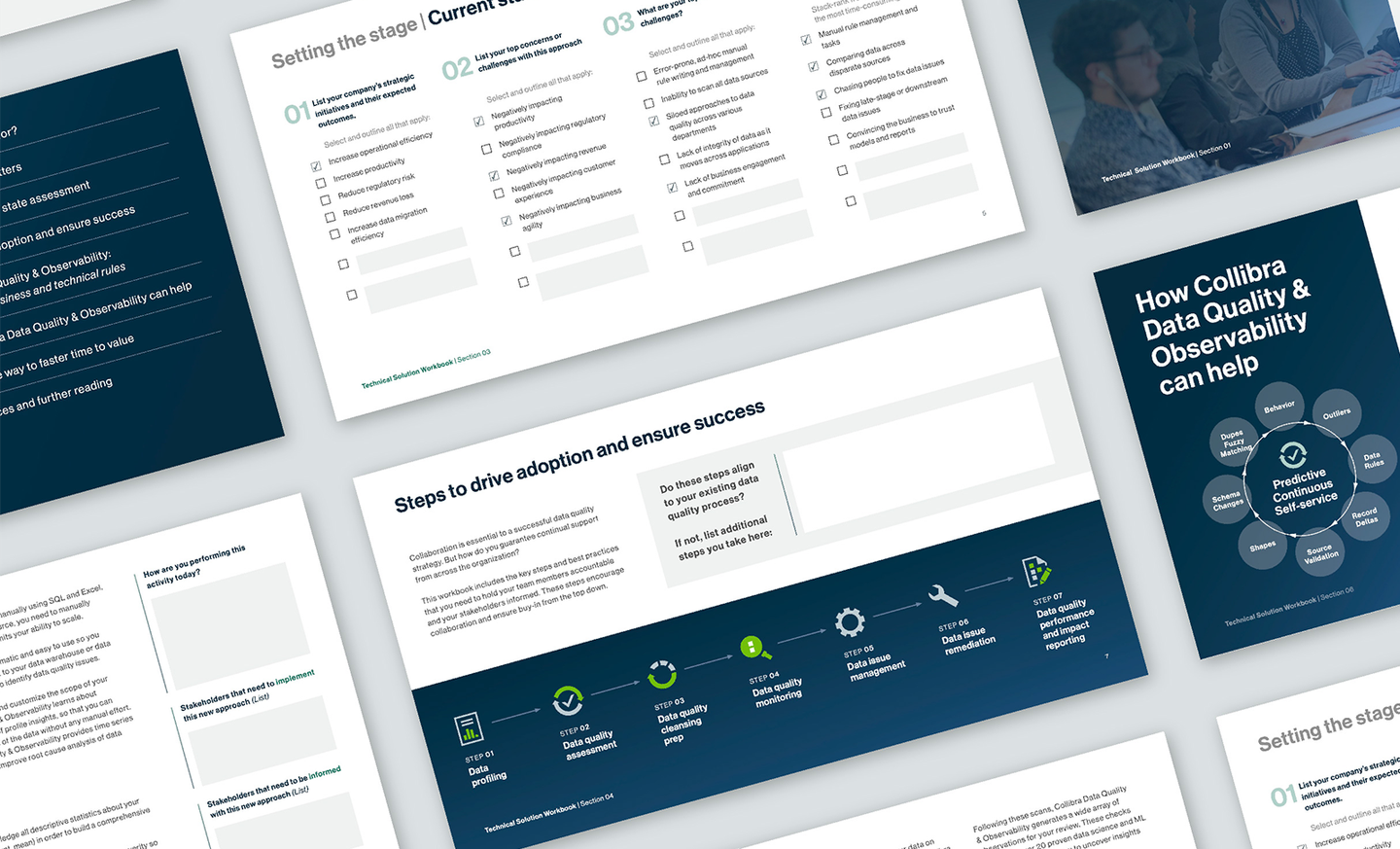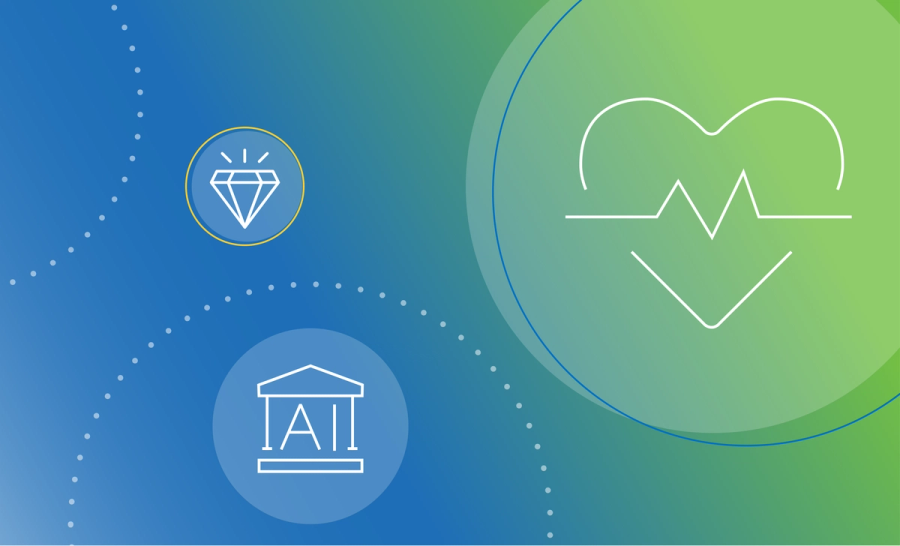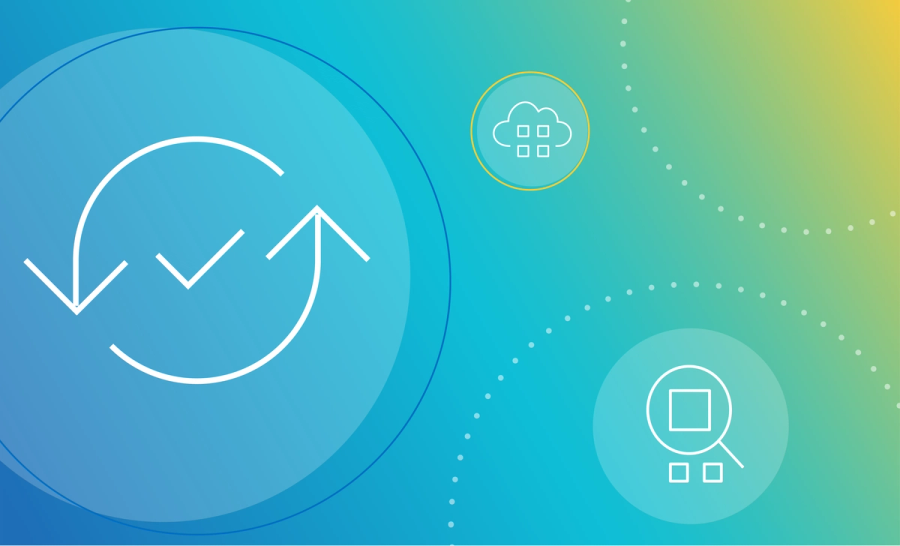How to accelerate time to value with predictive data quality and observability

High-quality data drives trusted decisions. But assuring constant access to high-quality data is a challenge, especially when you want to do it comprehensively and rapidly. The Collibra Technical Solution Workbook gives step-by-step guidance on achieving high data quality with Collibra Data Quality & Observability.
The interactive workbook helps you discover, analyze, and remediate your specific data issues, collaborating with all your stakeholders.
Why does data quality adoption matter?
Delivering high-quality data is not a one-time activity. Nor can it be ad hoc. The processes that worked for a small organization no longer suffice as the organization grows. It needs a different approach to make data quality initiatives successful.
Start by asking questions specific to your organization.
- How are you leveraging data quality in your organization?
- How can you get everyone on board?
- What are the barriers to updating your data quality vision? Are they technical or cultural?
These questions will help you reach out to all the stakeholders, explaining why enterprise-wide data quality adoption matters.
What state of data quality are you targeting?
The challenges to achieving constant access to high-quality data depend on your current state and the future state you are targeting.
Potential questions to help you assess your current state:
- What are your strategic initiatives and their expected outcomes? Is it increasing operational efficiency or data migration efficiency? Is it reducing the regulatory risk or revenue loss?
- What are your top concerns or challenges with the current approach? Is it negatively impacting your productivity, revenue, customer experience, or business agility?
- What are the key challenges to maintaining data quality? One common challenge is that data loses integrity during the journey across various enterprise applications.
- What are the data quality activities you spend the most time on? Many organizations report manual rule management and repetitive tasks as their number one challenge.
Defining your future state starts with defining the new data quality capabilities you need, such as:
- Autonomous rule management
- Shareable rule templates
- Horizontal and vertical scalability
- A unified DQ scoring system
- Remediation workflows
- Data quality checks across data pipelines
- Data masking
- Lineage and time series analysis capabilities
- Proactive anomaly detection
- Data discovery and rule enforcement
Build your expectations around cost savings, productivity gains, and improving data compliance efforts across the organization.
Seven steps to drive data quality adoption and ensure success
The end-to-end collaborative approach of Collibra Data Quality and Observability is demonstrated in seven easy steps. These steps are designed to keep stakeholders informed and the team members accountable. You may be using some or all of these steps already. Or you may be using them in a slightly different sequence.
- Data profiling: By profiling data, observe all the aspects of data sources that you need to be aware of and classify the observed issues.
- Data quality assessment: Set up the assessment criteria for data quality, identifying the current rules you need to enforce or the new rules you need to write.
- Data quality cleansing prep: All cleansing and standardization activities depend on your domain and the depth of your rule library.
- Data quality monitoring: Perform regular quality checks by executing profiling and data quality rules. You also need to set up monitoring and how best to handle the data when quality issues arise.
- Data issue management: Assign new data quality issues to the respective data owners and follow up regularly to fix them at the source.
- Data issue remediation: Investigate deep-rooted data issues which may span multiple data sets and owners.
- Data quality performance and impact reporting: Report your efforts with performance metrics and the impact of the data quality issues.
This is where Collibra Data Quality & Observability can help. It provides you with all the critical components you require to plan around these data quality adoption steps. Making notes along the way can help you align the steps to your organizational requirements.

The benefits of Collibra Data Quality & Observability
Collibra Data Quality & Observability is designed to scale across your enterprise, providing data quality to the entire organization. All the data quality-related results are available at a central location, enabling you to report the health and maturity of your data quality efforts. Collibra Data Quality & Observability can help you:
- Improve your TCO ROI on data: 484% 3-year ROI and 34% improvement in staff time to address data errors
- Increase employee productivity: Eliminate up to 60% of manual data quality workloads with autonomous data quality rules.
- Reduce regulatory & compliance risks: Avoid seven-figure fines for non-compliance with BCBS 239, CCAR, HIPAA, GDPR, and other regulations.
- Cut costs: Accelerate cloud data migrations. One company saved 2000 hours of effort with rule-based data integrity validation.
Best practices for data quality adoption
Data quality adoption can be challenging. From getting everyone on board to sharing regular updates, each activity plays a critical role in the entire process. These are our three best practices to help you achieve a successful data quality adoption and ensure success.:
- Make a strong use case specific to your pain points. Take a snapshot of your current state and compare it with the future state you are targeting. Fine-tune your case using the seven steps of the data quality adoption process.
- Identify and implement the right solution that fulfills your requirements. Choose the most comprehensive solution that not only automates technical rules but also business rules for building trust in your data. Go for a solution that leverages a predictive approach to quality and scales effortlessly.
- Measure, report, and keep improving continuously. Data quality is an ongoing process, and continuous measurement helps find areas for improvement. Sharing the findings with all stakeholders is a practice that keeps everyone informed and enables them to contribute to the refinements.
With these best practices in mind, organizations can seamlessly implement a data quality strategy that ensures the use of trustworthy data across the entire enterprise. With our interactive technical workbook, you can define your pain points, sketch our your strategy, and learn more about how Collibra Data Quality & Observability can help.
Related articles

Data QualitySeptember 12, 2024
What is data observability and why is it important?

AIJuly 15, 2024
How to observe data quality for better, more reliable AI

Data QualityNovember 8, 2024
Announcing Data Quality & Observability with Pushdown for SAP HANA, HANA Cloud and Datasphere

Data QualityNovember 16, 2023
The data quality rule of 1%: how to size for success
Keep up with the latest from Collibra
I would like to get updates about the latest Collibra content, events and more.
Thanks for signing up
You'll begin receiving educational materials and invitations to network with our community soon.
